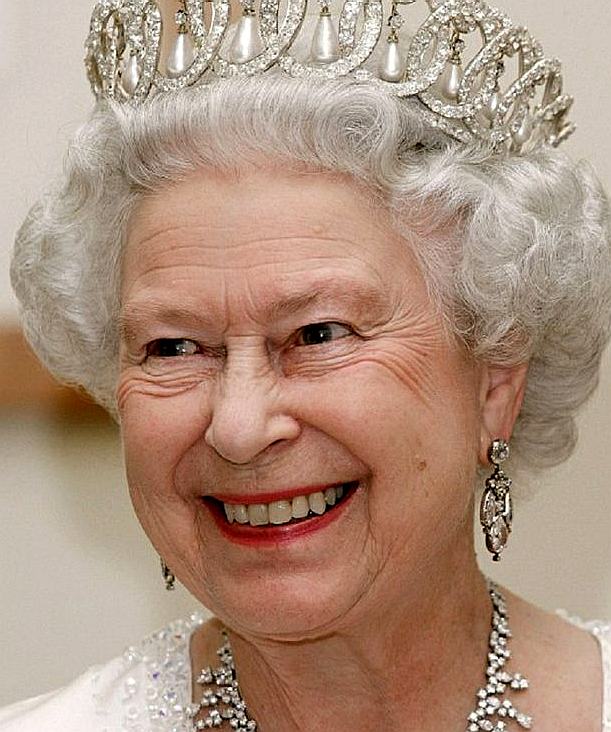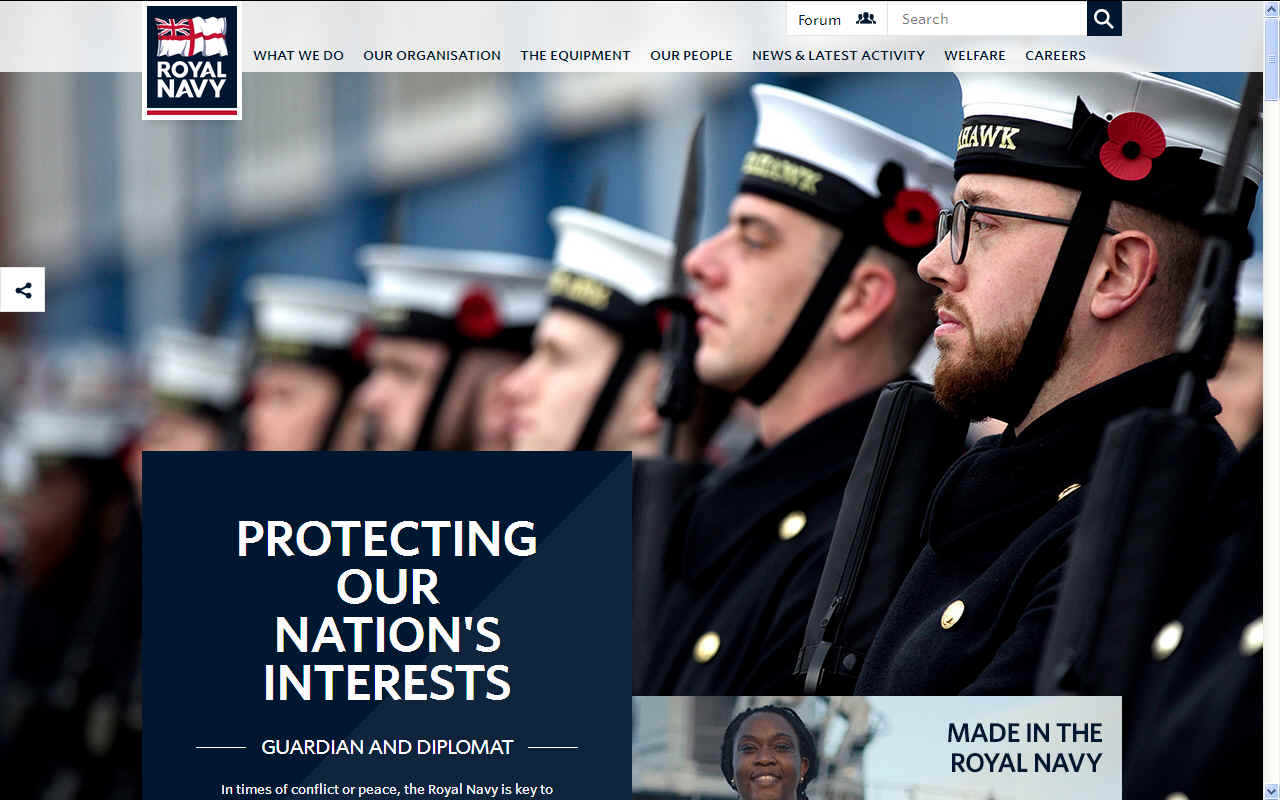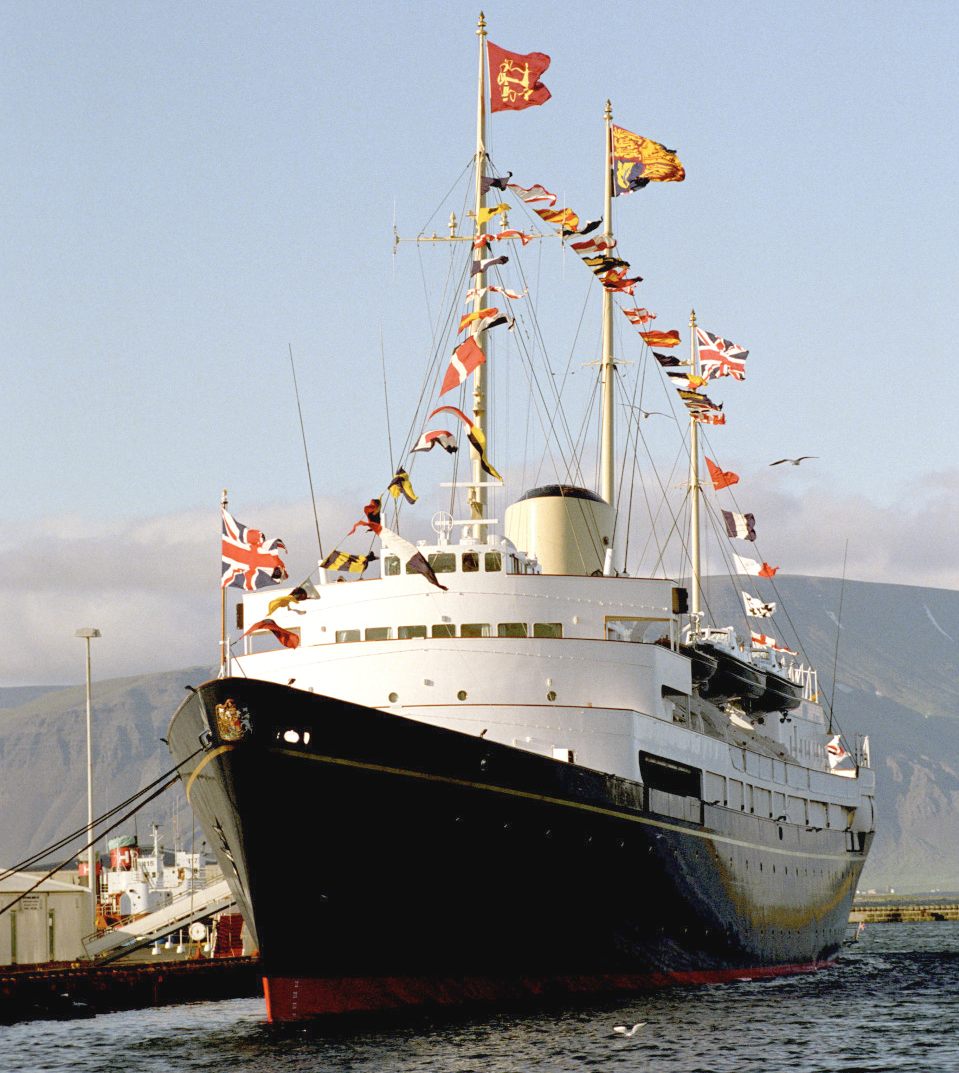
Her
Majesty, Queen Elizabeth
HMY
Britannia, also known as the Royal Yacht
Britannia, is the former royal yacht of the British monarch, Queen Elizabeth II, in service from 1954 until 1997.
She was the 83rd such vessel since King Charles II acceded to the throne in 1660, and is the second royal yacht to bear the name, the first being the racing cutter built for the Prince of Wales in 1893.
During her 43-year career, the yacht travelled more than a million nautical miles around the globe. Now retired from royal service, Britannia is permanently berthed at Ocean Terminal, Leith in Edinburgh, Scotland. It is a popular visitor attraction with over 300,000 visits each year.

JOHN BROWN CLYDEBANK
HMY Britannia was built at the shipyard of John Brown & Co. Ltd in Clydebank, Dunbartonshire,
builder of RMS
Queen Elizabeth and the QE2. She was launched by Queen Elizabeth II on 16 April 1953, and commissioned on 11 January 1954. The ship was designed with three masts: a 133-foot (41 m) foremast, a 139-foot (42 m) mainmast, and a 118-foot (36 m) mizzenmast. The top aerial on the foremast and the top 20 feet (6.1 m) of the mainmast were hinged to allow the ship to pass under bridges.
Britannia was designed to be converted into a hospital ship in time of war, although this capability was never used. In the event of nuclear war, it was intended for the Queen and Duke of Edinburgh to take refuge aboard Britannia off the north-west coast of Scotland.

CREWING
The crew of Royal Yachtsmen were volunteers from the general service of the Royal Navy. Officers were appointed for up to two years, while the "yachtsmen" were volunteers and after 365 days' service could be admitted to "The Permanent Royal Yacht Service" as Royal Yachtsmen and serve until they chose to leave the Royal Yacht Service or were dismissed for medical or disciplinary reasons. As a result, some served for 20 years or more. The ship also carried a troop of Royal Marines when members of the Royal Family were on board.

OPERATIONAL HISTORY
Britannia sailed on her maiden voyage from Portsmouth to Grand Harbour, Malta, departing on 14 April and arriving on 22 April 1954. She carried Princess Anne and Prince Charles to Malta in order for them to meet the Queen and the Duke of Edinburgh at the end of the royal couple's Commonwealth Tour. The Queen and the Duke of Edinburgh embarked on Britannia for the first time in Tobruk on 1 May 1954.
On 20 July 1959, Britannia sailed the newly opened Saint Lawrence Seaway en route to Chicago, where she docked, making the Queen the first British monarch to visit the city. US President Dwight D. Eisenhower was aboard Britannia for part of this cruise; Presidents Gerald Ford, Ronald Reagan and Bill Clinton were welcomed aboard in later years. Charles and Diana, the Prince and Princess of Wales, took their honeymoon cruise on Britannia in 1981. The ship evacuated over 1,000 refugees from the civil war in Aden in 1986. The vessel sailed to Canada in 1991 and made a port of call in Toronto and Kingston, Ontario.
HMY Britannia, when on royal duties, was escorted by a Royal Navy warship. The yacht was a regular sight at Cowes Week in early August and, usually, for the remainder of the month, was home to the Queen and her family for an annual cruise around the islands off the west coast of Scotland (known as the "Western Isles Tour").
During her career as Royal Yacht, Britannia conveyed the Queen, other members of the Royal Family and various dignitaries on 696 foreign visits and 272 visits in British waters. In this time, Britannia steamed 1,087,623 nautical miles (2,014,278 km).

DECOMMISSIONING
In 1994, the Conservative government announced the yacht's retirement:
The yacht last underwent a major refit in 1987. A further refit at an estimated cost of some £17 million would be necessary in 199697 but would only prolong her life for a further five years. In view of her age, even after the refit she would be difficult to maintain and expensive to run. It has therefore been decided to decommission "Britannia" in 1997. The Government will now consider the question of whether to replace "Britannia".
Viscount Cranborne, House of Lords Hansard: Written Answers 23 June 1994
In January 1997, the government committed itself to replacing the Royal Yacht if reelected. The timing of the announcement, close to a general election, was controversial; The Guardian Weekly called it "part of a populist appeal to wavering Tory voters in the run-up to the general election" and reported that the Queen was "furious" that the royal family was "dragged into the centre of the election campaign, just as it is fighting to restore its public image."
Sir Edward Heath publicly objected to the government's handling of the issue, stating "The
Conservative Party above all must be an honourable party. And I don't believe the actions that have been taken are honourable ones and should never have been taken in this way."
The government argued that the cost was justified by its role in foreign policy and promoting British interests abroad, particularly through conferences held by British Invisibles, formerly the Committee on Invisible Exports. It was estimated by the Overseas Trade Board that events held on board the yacht helped raise £3 billion for the treasury between 1991 and 1995 alone.
The Labour opposition announced it would not commit the use of public funds for a replacement vessel for at least the first 2 years of any new Labour government. After its election victory in May 1997, the new government considered multiple options for the future of a royal yacht, but concluded in October of that year that Britannia would not be replaced:
We made clear that we would not spend public money on a Royal Yacht and I am keeping that promise. We in the Ministry of Defence have to justify every penny of the taxpayers' money that we spend and in this case I could not do so, particularly - as the Queen has made clear - since a Yacht is not needed for Royal travel. We considered in detail all private finance options, but these would only have been viable with a substantial annual subsidy from public funds.
George Robertson, Defence Secretary,
The Royal Yacht's final foreign mission was to convey the last governor of Hong Kong, Chris Patten, and the Prince of Wales back from Hong Kong after its handover to the People's Republic of China on 1 July 1997. Britannia was decommissioned on 11 December 1997. The Queen, normally undemonstrative, is reported to have shed a tear at the decommissioning ceremony that was attended by most of the senior members of the Royal Family.
Proposals for the construction of a new royal yacht, perhaps financed through a loan or by the Queen's own funds, have made little headway. In December 2019 it was reported that the late Donald Gosling has donated £50 million in his will to pay for it.

COMMANDING OFFICERS
Captain J. S. Dalglish, 7 January 28 April 1954
Vice Admiral Sir Conolly Abel Smith, 28 April 1954 30 January 1958
Vice Admiral Sir Peter Dawnay, 30 January 1958 25 January 1962
Rear Admiral Sir Joseph Henley, 25 January 1962 9 March 1965
Rear Admiral Sir Patrick Morgan, 9 March 1965 1 September 1970
Rear Admiral Sir Richard Trowbridge, 1 September 1970 11 September 1975
Rear Admiral Sir Hugh Janion, 11 September 1975 4 February 1981
Rear Admiral Sir Paul Greening, 4 February 1981 12 September 1985
Rear Admiral Sir John Garnier, 12 September 1985 18 September 1990
Rear Admiral Sir Robert Woodard, 18 September 1990 1 April 1995
Commodore A. J. C. Morrow, 1 April 1995 11 December 1997

RETIREMENT
Listed as part of the National Historic Fleet, Britannia is a visitor attraction moored in the historic Port of Leith in Edinburgh, Scotland, and is cared for by the Royal Yacht Britannia Trust, a registered charity. There was some controversy over the siting of the ship, with some arguing that she would be better moored on the River Clyde, where she was built, than in Edinburgh, with which the yacht had few links. Her positioning in Leith coincided with a redevelopment of the harbour area, and the advent of Scottish devolution.
Entrance to the yacht is via the Ocean Terminal development, and over 300,000 people visit the Royal Yacht Britannia every year. She is also one of the UK's top evening events venues. On 18 May 2006, the Swiss-born Hollywood actress and first Bond girl, Ursula Andress, celebrated her 70th birthday on board the former royal yacht. On 29 July 2011, a drinks reception was held on board Britannia for Queen Elizabeth's granddaughter Zara Phillips and her then fiancι, Mike Tindall to celebrate their upcoming wedding.
An early Land Rover in much-restored shape is displayed in the on-board garage, while a retired Rolls-Royce Phantom V state car is parked on the wharf below the ship. The tour of the five decks open to the public includes the Queen's Bedroom, which can be viewed behind a glass wall, and the State Dining and Drawing Rooms, which hosted grand receptions for kings and queens, presidents and prime ministers throughout the world. The clocks on board are stopped at 3:01, the time that the Queen last disembarked. The Royal Deck Tea Room was added in 2009.
The 1936 racing yacht Bloodhound, once owned by the Queen and Prince Philip, is now berthed alongside Britannia. Bloodhound was one of the most successful ocean-racing yachts ever built and was also the yacht on which both the Prince of Wales and Princess Royal learned to sail. The Royal Yacht Britannia Trust bought
Bloodhound in early 2010 and she is the centrepiece of an exhibition focusing on the Royal Family's passion for sailing. Visitors can view Bloodhound from a specially built pontoon when the racing yacht is in port. During July and August, she is berthed in Oban Marina and is available for private charter, as she sails around the islands once visited by the royal family during their annual two-week holiday in the Western Isles of Scotland. During this period, Royal Yachtsmen (Yotties) from Britannia's original crew sail the yacht for the Britannia Trust.

VESSELS
NAMES QUEEN ELIZABETH
The
are a number of vessels that bear the name: "Queen Elizabeth."
Their are three Cunard liners: RMS Queen
Elizabeth, Queen Elizabeth 2
(QE2) and MS Queen Elizabeth (QE), a nuclear powered aircraft
carrier, HMS Queen
Elizabeth (RO8), HMS Queen Elizabeth dreadnought class battleship, and a
solar powered Canadian canal
boat. Of
these in pollution terms, the canal boat is a shining star. The dirtiest
is the RO8, because of the dumping of spent nuclear material in the
oceans.
AMBIGUITY
There
is no connection between any of the vessels listed and the Elizabeth
Swann, except perhaps for the sources of inspiration.
The
name 'Elizabeth' in the context of the solar powered Elizabeth
Swann, comes from Miss
Swann, a fictional
character in the Pirates of the Caribbean series of films by Disney,
though Her Majesty has been inspirational in many areas and we feel sure
would find interesting as a concept.
With
the International
Maritime Organization making moves to cleaner ocean transport, now
demanding low sulfur diesel
fuels, (electric) solar and wind powered shipping could be
the pinnacle of environmental achievement - if it comes to pass.
We
would hope that the IMO outlaws nuclear powered ships and submarines as
part of a move to world peace. We should be aiming for zero carbon and
zero radiation shipping.

LINKS
& REFERENCE
https://www.royalnavy.mod.uk/
https://www.bbc.co.uk/news/uk-23272491
https://www.royal.uk/royal-family
Please use our
A-Z INDEX to
navigate this site








